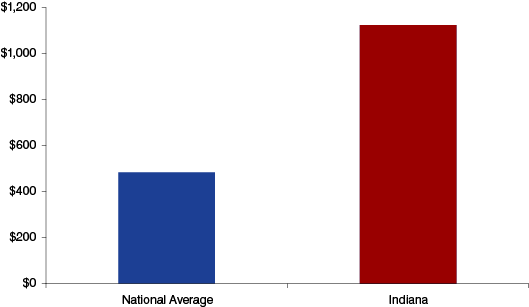Life Science Industries Increase Indiana's Personal Income
A measure of the productivity of an industrial sector is to consider the degree to which it raises the personal income—or standard of living—of a state’s residents. Indiana’s per capita personal income (PCPI), and the degree to which it lags the national average and the increasingly widening gap, is something of a sore point. Not including the District of Columbia, the state’s PCPI ranked 40th in the nation in 2011.
Those wishing to highlight the importance of the life sciences to the Indiana economy would do well to present the “but for the life sciences” scenario as it relates to Indiana’s PCPI. The analysis is easy: remove the compensation of the life science industries from the state’s total personal income, place on a per capita basis and recast the ranking of PCPI-less-the-life-sciences.
Unfortunately, the data are somewhat uncooperative. The life sciences are a collection of relatively specific (six-digit NAICS) industries across several industries sectors. The Bureau of Economic Analysis, however, only reports compensation by industry at the state level at higher levels of industry aggregation. Just the same, one can make some ballpark estimates of the impact of the life sciences on the state using a couple of three-digit industries that are composed mostly of the life sciences, namely chemical manufacturing—pharmaceuticals and agricultural chemicals are included in this—and miscellaneous manufacturing. True, this method leaves some life science industries uncounted (for example, apparatus manufacturing and research and development in biotechnology) and includes other industries not in the life sciences, like the production of sporting goods. The degree to which there is some evening out given the pluses and minuses is unknown.
For the sake of argument, let’s make the heroic assumption that the compensation associated with chemical manufacturing and miscellaneous manufacturing is a good proxy for what the life sciences contribute to personal income.
What are the results? Indiana’s PCPI moves from ranking 40th in the country to 42nd in the country for PCPI-less-the-life-sciences (see Table 1). That’s a profound shift considering that the two life science proxy industries make up only 1.1 percent of the nation’s compensation.
Table 1: Change in Indiana’s National Rank, 2011
| Indicator | Rank with the Life Sciences | Rank without the Life Sciences |
|---|---|---|
| Per Capita Personal Income | 40 | 42 |
| Per Capita Wages and Salaries | 35 | 41 |
Source: IBRC, using Bureau of Economic Analysis data
Personal income includes not only wages and salaries, but also dividends, royalties, rental income, etc. If we look at just the wages and salaries portion of personal income, Indiana’s drop in the rankings is even more profound. Indiana’s per capita wages and salaries ranks 35th (showing that the state is highly dependent on labor income rather than transfer payments, returns to capital or intellectual property compared to other states). Pull out the life science proxy industries and Indiana’s rank falls to 41st.
The most telling statistic, however, is the difference in PCPI and PCPI-less-the-life-sciences. Remove the life sciences, and Indiana’s personal income per person would drop $1,124, the second greatest absolute descent in the nation behind New Jersey with a drop of $1,328. In percentage terms, Indiana’s drop is greater at 3.1 percent compared to New Jersey (second in percentage terms at 2.5 percent).
With the headquarters of Johnson & Johnson, Merck, Wyeth, and Schering-Plough, to name a few, it should be noted that New Jersey also has a massive chemical industry presence that contributes mightily to their PCPI. New Jersey has almost twice the number of production workers in the chemical industry than Indiana and 2.6 times the number of non-production workers. Those non-production workers earn, on average, the highest salary for that industry in the nation, almost $117,000 per annum compared to Indiana’s $85,400. (Indiana’s average production worker annual wage exceeds New Jersey by more than $3,000 a year.) The employment disparity in miscellaneous manufacturing is not nearly as profound. Despite having a considerable disadvantage in employment headcount in the two industries, Indiana’s value of shipments exceeds New Jersey’s.
The national average for the drop in PCPI that would result from removing the proxy life science industries’ compensation is $484, or about 1.2 percent (see Figure 1). In other words, without the life sciences, the PCPI gap between the nation and Indiana would expand by $640, or, in percentage terms, by another 1.5 percent.
Figure 1: Impact of the Life Science Industry on Per Capita Personal Income, 2011

Source: IBRC, using Bureau of Economic Analysis data
The life sciences are significantly pulling up Indiana’s personal income and Hoosiers should be grateful that this state is blessed with such a presence.
